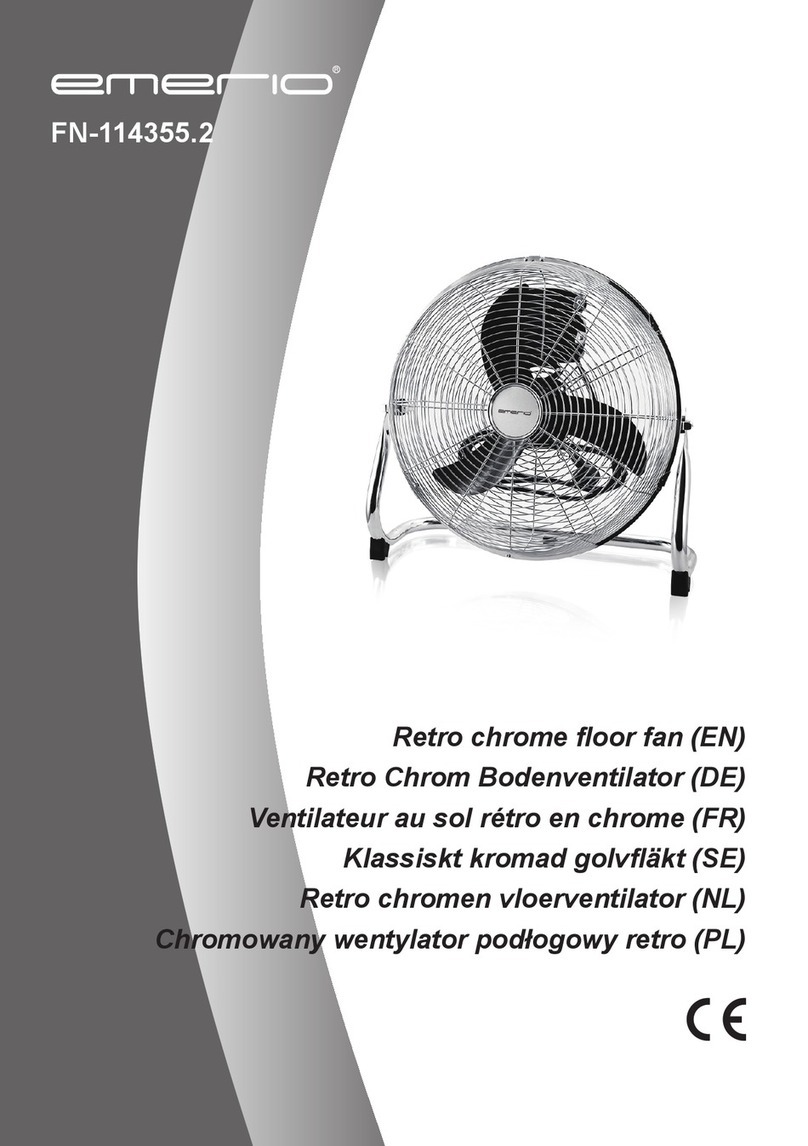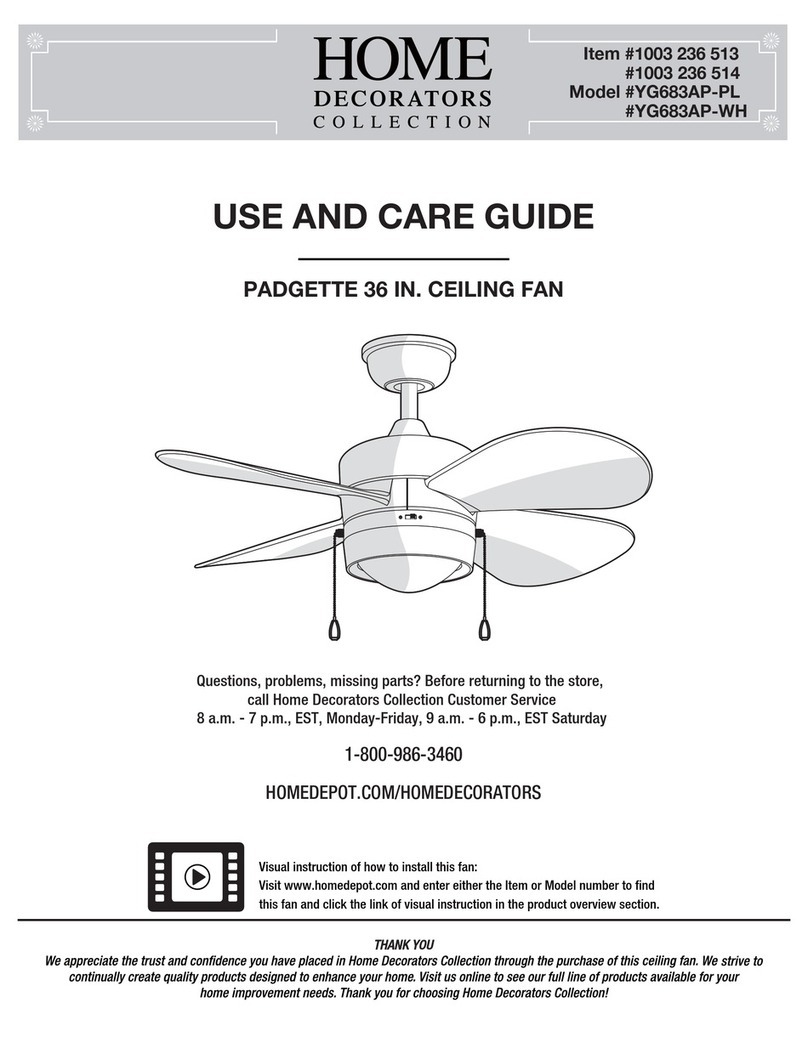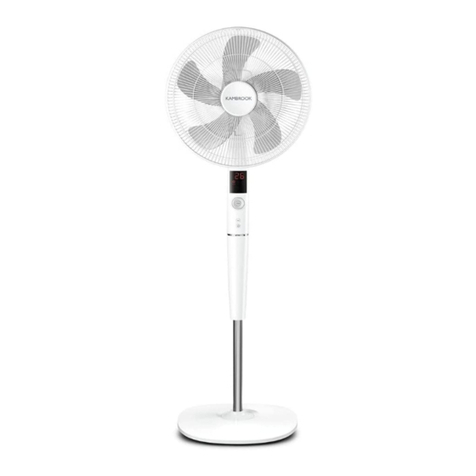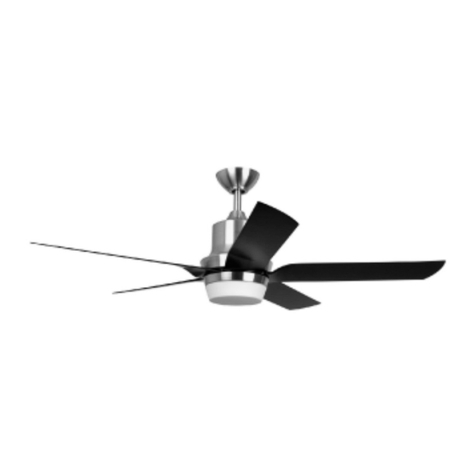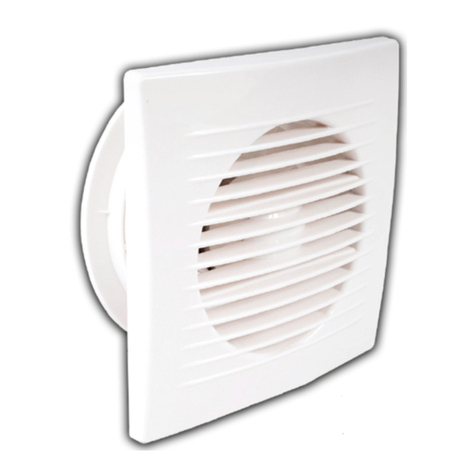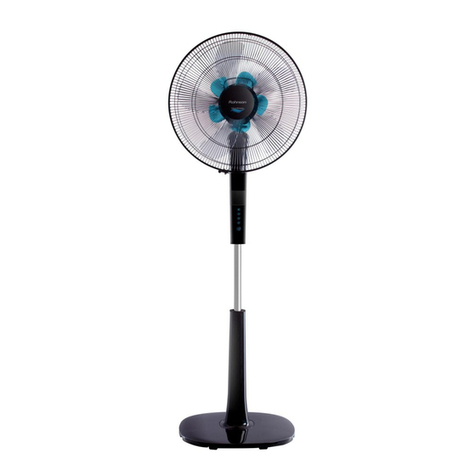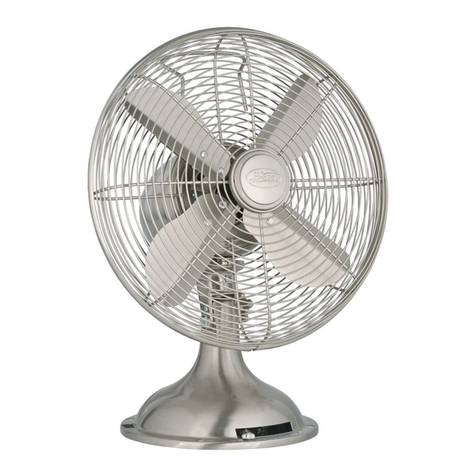General Equipment EP8HL User manual

OPERATOR MANUAL
Includes Safety, Service and Replacement Part Information
Model EP8HL
Hazardous Location
Ventilation Blower
Form: GOM7069501
Version 1.3
Do not discard this manual. Before operation, read and
comprehend its contents. Keep it readily available for reference
during operation or when performing any service related
function. When ordering replacement parts, please supply the
following information: model number, serial number and part
number. For customer service assistance, telephone
800.533.0524, +507.451.5510. Our Customer Service Department
telefax number is 877.344.4375 (DIGGER 5), +507.451.5511.
There is no charge for customer service activities .
Internet address: http://www.generalequip.com.
E-Mail location: [email protected].
Copyright 2003, General Equipment Company.


Manufacturers of light construction
equipment
620 Alexander rive SW • P.O. Box 334 • Owatonna, Minnesota 55060-0334 USA
Telephone: 800.533.0524 • International Telephone: +507.451.5510
Telefax: +507.451.5511 • Sales/Customer Service epartment Toll Free: 877.344.4375 ( IGGER 5)
http://www.generalequip.com • e-mail: [email protected]
Congratulations on your decision to purchase a General light construction product. From our
humble beginnings in 1955, it has been a continuing objective of General Equipment Company to
manufacture equipment that delivers uncompromising value, service life and investment return.
Because of this continuous commitment for excellence, many products bearing the General name
actually set the standards by which competitive products are judged.
When you purchased this product, you also gained access to a team of dedicated and
knowledgeable support personnel that stand willing and ready to provide field support
assistance. Our team of sales representatives and inhouse factory personnel are available to
ensure that each General product delivers the intended performance, value and investment return.
Our personnel can readily answer your concerns or questions regarding proper applications,
service requirements and warranty related problems.
General Equipment Company places great emphasis upon not only product performance, but also
on product safety. It is important to remember that this product will only be as safe as the operators
which utilize it. It just makes good, common sense to take the time to read and fully understand the
contents of this manual before attempting to utilize this product in service. If you ever do have any
questions or concerns about this product, please feel free to contact our Customer Service
epartment at the telephone numbers listed below for assistance.
If there is anything that I can do to assist your efforts when utilizing this product, please do not
hesitate to contact me. For assistance after normal business hours, telephone me at 507.451.9409
or 507.363.1033. If I am not immediately available, I will attempt to return your call as soon as
possible.
Sincerely,
GENERAL EQUIPMENT COMPANY
ennis Von Ruden
President
G
E
N
E
R
A
L
E
Q
U
I
P
M
E
N
T
C
O
M
P
A
PAP
N
Y
e
n
n
i
s
V
o
VoV
n
R
u
d
e
n

EP8HL HAZARDOUS BLOWER
FORM GOM7069501, VERSION 1.2 2
DESCRIPTION PAGE
Notice To Operator
Operational Instructional ata Sheet
Safety Precautions
PREPARATION.
OPERATION.
MAINTENANCE, REPAIR AN STORAGE.
Assembly
INSTALLING THE RUBBER MOUNTS TO THE FRAME.
INSTALLING THE LIFTING HAN LE.
Introduction
WARNINGS TO OPERATORS
MO EL EP8HL BLOWER ESIGN CONSI ERATIONS.
MO EL EP8HL BLOWER OPERATING CLASSIFICATIONS AN LIMITATIONS.
Blower Operation
NATIONAL ELECTRIC CO E ISCLAIMER.
CONFINE SPACE REGULATION ISCLAIMER.
BASIC INFORMATION AN EFINITIONS PERTAINING TO CONFINE SPACE REGULATIONS.
HAZAR OUS LOCATION ATMOSPHERE CERTIFICATION STAN AR S FOR THE MO EL EP8HL BLOWER.
BASIC EFINITIONS OF HAZAR OUS LOCATIONS TYPE ATMOSPHERS.
AIR VENTILATION BLOWER APPLICATIONS FOR CONFINE SPACE USE IN HAZAR OUS LOCATION TYPE
ATMOSPHERES.
SPARK PROOF CONSTRUCTION CONSI ERATIONS FOR HAZAR OUS LOCATIONS TYPE CONFINE
SPACE VENTILATION.
STATIC ELECTRICITY CONSI ERATIONS FOR HAZAR OUS LOCATION TYPE CONFINE SPACE
VENTILATION.
EXPLOSIVE CHEMICAL PROPERTIES CONSI ERATIONS FOR HAZAR OUS LOCATION
TYPE CONFINE SPACE VENTILATION.
FLOW RATES FOR MO EL EP8HL HAZAR OUS LOCATION, PORTABLE AIR VENTILATION BLOWER.
CONNECTING THE MO EL EP8HL BLOWER TO THE POWER SOURCE.
USE OF THE FACTORY SUPPLIE , STATICALLY CON UCTIVE UCTS WITH THE MO EL EP8HL BLOWER.
GENERAL INFORMATION REGAR ING PORTABLE AIR VENTILATION BLOWER USE URING CONFINE
SPACE ENTRY.
TYPICAL CONFINE SPACE AIR VENTILATION PROCE URES.
STOPPING THE MO EL EP8HL BLOWER.
Service:
BLOWER HOUSING MAINTENANCE.
REMOVING THE BLOWER WHEEL FROM THE MOTOR SHAFT.
ELECTRIC MOTOR MAINTENANCE.
STATICALLY CON UCTIVE UCT MAINTENANCE.
Trouble Shooting
ELECTRIC MOTOR FAILS TO OPERATE.
BLOWER LACKS AIR FLOW ELIVERY.
Storage
Specifications
Appendix
Replacements Parts iagram
3
5
6
6
8
9
10
10
10
12
12
12
13
14
14
15
15
15
16
16
16
17
17
18
18
21
24
26
28
28
28
28
30
30
32
32
32
32
32
33
46
Table of Contents

EP8HL HAZARDOUS BLOWER
FORM GOM7069501, VERSION 1.2 3
Notice to Operators
IF YOU CAN NOT READ OR DO NOT FULLY UNDERSTAND THE CONTENTS OF
THIS MANUAL, PLEASE CONTACT THE FACTORY FOR PROPER ASSISTANCE
BEFORE ATTEMPTING TO OPERATE THIS PRODUCT.
SI TU NO PUEDES LE’ER O NO COMPRENDES EL CONTENIDO DE ESTE MANUAL
FAVOR DE PONERSE EN CONTACTO CON LA. FABRICA PARA ASSISTENCIA- A
PROPIA ANTES DE INTENTAR PARA OPERAR ESTE PRODUCTO.
SOLLTEN SIE DIESE GEBRAUCHSANWEISUNG NICHT LESEN KOENNEN ODER
ES NICHT VOLLKOMMEN VERSTEHEN, WENDEN SIE SICH BITTE AN DEN
HERSTELLER FUER RICHTIGE HILFE EHE SIE VERSUCHEN DIESES PRODUKT
ZU OPERIEREN.
SI VOUS NE LISEZ OU NE COMPRENDRE ENTIEREMENT LES MATIERES DE CE
MANUEL, S’IL VOUS PLAIT, CONTACTEZ L’USINE POUR L’ASSISTANCE
APPROPRIEE AVANT D’UTILISER LE PRODUIT.
These safety alert symbols identify important safety messages in this manual. When you see these
symbols, be alert to the possibility of personal injury and carefully read the message that follows.
Do not allow anyone to operate the Blower without first reading this Operator's Manual and becoming
familiar with its operation. The manufacturer of this Blower has gone to great extremes to provide the
owner(s) and/or operator(s) with the finest equipment available for its intended job function of providing
air for portable ventilation purposes. Yet, the possibility exists that the Blower can be utilized in and/or
subjected to job applications not perceived and/or anticipated by the manufacturer. Such misuse and/or
misapplication of the Blower can lead to the possibility of serious damage, injury or even death. It is the
responsibility of the owner(s) and/or operator(s) to determine that the Blower is being utilized and/or
operated within the scope of its intended job function. It is the responsibility of the owner(s) and/or
operator(s) to establish, monitor and constantly upgrade all safety programs and/or practices utilized in
and for the operation of the Blower. The purpose of such programs is to provide for owner(s') and/or
operator(s') safety. Operators must be instructed to recognize and avoid unsafe conditions associated
with their work (29 CFR 1926.21 (b)(2)) and/or applicable updated revisions. It is the responsibility of the
owner(s) and/or operator(s) to determine that no modifications and/or alterations have been made to the
Blower. Modifications and/or alterations can lead to the possibility of serious damage, injury or even
death. It is the responsibility of the owner(s) and/or operator(s) to make this Operator's Manual available
for consultation during all phases of operation. Refer to OSHA 2207 and/or applicable updated revisions
which contains all OSHA job safety and health rules and regulations (1926 and 1910) covering
construction.
The concept of portable air ventilation blowers has been successfully utilized for many years as a practical
solution to many types of air ventilation job requirements. The basic concept is proven and well accepted
within the associated marketplaces. Use of a Blower requires strenuous work activity. This type of work

EP8HL HAZARDOUS BLOWER
FORM GOM7069501, VERSION 1.2 4
activity can be considered to be greater in magnitude than that experienced with the use of many other
types of both light construction and lawn and garden related equipment. This type of work activity should
only be attempted by operators of adequate physical size and stature, mental awareness and physical
strength and condition. The body parts most noticeably affected during the ventilation process are the
arms, hands, wrists, shoulders, lower back and legs. The ventilation process can also produce excessive
stress/strain directly to the back muscles, spinal vertebrae and many other body parts. Back related pain
can be a side effect of utilizing a Blower. An operator with a chronic back related problem or a history of
back and/or other medically related problems should not attempt to utilize the Blower. Use of the Blower
may only aggravate this and any other medically related problem. Because of the diverse type of
prevailing job applications, job site conditions, operator experience levels and operator physical
characteristics, no warranty, guarantee, representation and/or liability is made by the manufacturer as to
the absolute correctness or sufficiency of any operational procedure, operational position and/or
technique. There is no absolute guarantee that an operator of any given experience level, physical size
and/or physical condition will be immune to the possibility of and/or probable physical side effects of the
normal use of the Blower. Each potential operator of the Blower must be made aware of and assume the
operational and physical liability described and/or associated with the use of the Blower. Each potential
operator not willing to assume the operational and physical liability described and/or associated with the
use of the Blower should not operate the Blower. Proper levels of operator experience, skill and common
sense are essential for maximizing the safe and efficient operation of the Blower.
Record the Blower and engine/electric motor serial numbers in the spaces provided
below.
_______________ Model Number
_______________ Serial Number
_______________ Engine/Electric Motor Serial Number
_______________ Date of Purchase
Specifications and design are subject to change without notice or obligation. All specifications are
general in nature and are not intended for specific application purposes. General Equipment Company
reserves the right to make changes in design, engineering or specifications and to add improvements or
discontinue manufacture at any time without notice or obligation. General Equipment Company and its
agents accept no responsibility for variations which may be evident in actual products, specifications,
pictures and descriptions contained in this publication.

EP8HL HAZARDOUS BLOWER
FORM GOM7069501, VERSION 1.2 5
Operator Instructional Data Sheet
The following undersigned operators of the Blower described and/or pertaining to this Operator's Manual have
received formal safety and operational information/instruction from the undersigned owner(s)/instructor(s) in
accordance to OSHA 29 CFR 1926.21 (b)(2) and/or applicable updated revisions pertaining to, but not necessarily
limited to the:
1) READING, COMPREHENSION AND ACKNOWLEDGEMENT OF THE MATERIAL COMPRISING THE
ENTIRE CONTENTS OF THE APPLICABLE OPERATOR'S MANUAL AND SAFETY AND OPERATIONAL
INFORMATION VIDEO TAPE FOR THE BLOWER.
2) FORMALIZED OPERATOR'S SAFETY PROGRAM TO BE DEVISED BY THE OWNER OF THE BLOWER IN
CON UNCTION WITH THE CONTENTS OF THE APPLICABLE OPERATOR'S MANUAL AND SAFETY AND
OPERATIONAL INFORMATION VIDEO TAPE FOR THE BLOWER.
3) OSHA RULES AND REGULATIONS RESEARCHED FOR AND/OR BY THE OWNER OF THE BLOWER AND
DEEMED APPLICABLE TO THE SAFE AND PROPER USE AND/OR OPERATION OF THE BLOWER FOR ANY
SPECIFIC OB APPLICATION.
4) LOCAL LAWS, REGULATIONS AND CUSTOMS RESEARCHED FOR AND/OR BY THE OWNER OF THE
BLOWER AND DEEMED APPLICABLE TO THE SAFE AND PROPER USE AND/OR OPERATION OF THE
BLOWER FOR ANY SPECIFIC OB APPLICATION.
5) FORMALIZED MAINTENANCE PROGRAM FOR THE BLOWER AND STATICALLY CONDUCTIVE DUCT(S)
TO BE DEVISED BY THE OWNER OF THE BLOWER IN ACCORDANCE WITH, BUT NOT NECESSARILY
LIMITED TO, THE SPECIFICATIONS, GUIDELINES AND OPERATIONAL INFORMATION CONTAINED IN THE
APPLICABLE OPERATOR'S MANUAL.
6) COMPREHENSIVE OPERATIONAL INSTRUCTIONS FOR THE CORRECT AND PROPER USE OF THE
BLOWER AS PER THE CONTENTS OF THE APPLICABLE OPERATOR'S MANUAL AND SAFETY AND
OPERATIONAL INFORMATION VIDEO TAPE.
_______________ Operator _______________ Owner/Instructor __________ Date
_______________ Operator _______________ Owner/Instructor __________ Date
_______________ Operator _______________ Owner/Instructor __________ Date
NOTE: INSERT COPIES OF THIS PAGE WITHIN THE OPERATOR'S MANUAL IF SPACE FOR ADDITIONAL
OPERATORS IS REQUIRED.

Safety Precautions
MODEL EP8HL PORTABLE AIR
VENTILATION BLOWER.
THE FOLLOWING SAFETY PRECAUTIONS
PROVIDE SOME COMMON SENSE GUIDES TO
PROMOTE SAFETY AND EFFICIENCY WITH THE
BLOWER. NO WARRANTY, GUARANTEE OR
REPRESENTATION IS MADE BY THE
MANUFACTURER AS TO THE ABSOLUTE
CORRECTNESS OR SUFFICIENCY OF ANY
INFORMATION OR STATEMENT. THESE SAFETY
PRECAUTIONS ARE INTENDED TO DEAL
PRINCIPALLY WITH COMMON PRACTICES AND
CONDITIONS ENCOUNTERED IN THE USE OF THE
BLOWER AND ARE NOT INTENDED TO BE ALL
INCLUSIVE. PROPER LEVELS OF OPERATOR
EXPERIENCE, SKILL AND COMMON SENSE ARE
ESSENTIAL FOR SAFE AND EFFICIENT
OPERATION. THE BLOWER IS DESIGNED FOR
PORTABLE AIR VENTILATION PURPOSES ONLY.
THE BLOWER IS NOT DESIGNED FOR
TRANSPORTING LIQUID, SEMI-SOLID OR SOLID
MATERIALS. INCORRECT USE OF THE BLOWER
CAN RESULT IN AN ELECTRICAL SHOCK AND/OR
ELECTROCUTION. ALWAYS OPERATE THE
BLOWER IN COMPLIANCE WITH CURRENT OSHA
AND NATIONAL ELECTRIC CODE®
REGULATIONS.
INCORRECT USE OF THE BLOWER CAN RESULT
IN PROPERTY DAMAGE, PERSONAL IN URY OR
EVEN DEATH. TO REDUCE THIS POSSIBILITY,
GIVE COMPLETE AND UNDIVIDED ATTENTION TO
THE OB AT HAND AND FOLLOW THESE SAFETY
PRECAUTIONS.
PREPARATION
1) This Blower is a specialized type of powered
equipment, designed for a specific job function and
requires adequate and thorough instruction BEFORE it
is operated. Each operator must receive adequate,
professional instruction regarding the proper operation
of this Blower BEFORE being allowed to operate it.
Refer to OSHA 2207 (and/or applicable updated
revision) which contains all OSHA job safety and health
rules and regulations (1926 and 1910) covering
construction. BEFORE attempting to utilize this Blower,
read this Operator's Manual and view the safety and
operational information video tape supplied by the
manufacturer to familiarize each operator with its
correct operating procedures. When you are going to
utilize this Blower- O IT RIGHT-avoid the urge not to
take the time to read this Operator's Manual BEFORE
utilizing the Blower. O NOT OPERATE THIS
BLOWER UNTIL EACH OPERATOR COMPLETELY
COMPREHEN S THE CONTENTS OF THIS
MANUAL AN HAS VIEWE THE SAFETY AN
OPERATIONAL INFORMATION VI EO TAPE.
2) evelop a comprehensive program for the safe
operation of the Blower by its owner(s) and/or
operator(s). Such a program will include, but is not
limited to: instructional requirements for operation,
applicable OSHA requirements, local laws and
regulations, job site safety and a Blower maintenance
program. Constantly examine and upgrade this
program to guarantee owner(s) and/or operators(s)
safety. Each operator must be fully instructed
regarding the specifics of this safety program. Refer to
(29 CFR 1926.21 (b) (2)) and/or current revision.
3) etermine that the Blower is in its original, factory
configuration and has not been modified in any
manner. Many modifications can result in potentially
dangerous configurations that can lead to property
damage and/or personal injury. If there are any
questions about possible modifications made to the
Blower, contact the Customer Service epartment for
specific information BEFORE utilization. There is no
charge for this service.
4) Minors should never be allowed to operate the
Blower. Bystanders, especially children and animals
should not be allowed in the area where a Blower is in
use.
5) Operators must be in adequate physical condition,
mental health and not under the influence of any
substance (drugs, alcohol, etc.) which might impair
vision, dexterity or judgement. Working with the Blower
can be strenuous. If you have any condition that might
be aggravated by strenuous work, check with your
EP8HL HAZARDOUS BLOWER
FORM GOM7069501, VERSION 1.2 6

EP8HL HAZARDOUS BLOWER
FORM GOM7069501, VERSION 1.2 7
doctor BEFORE operating the Blower. Guard against
the possibility of back related injuries. Always lift the
Blower with leg muscles and not with the back.
6) Clothing must be sturdy and snug fitting, but allow
complete freedom of movement. Never wear loose
fitting jackets, scarves, neckties, jewelry, flared or
cuffed pants or anything that could become caught on
controls or moving parts. Wear long pants to protect
your legs. Protect your hands with heavy duty, nonslip
gloves to improve your grip. Good footing is most
important when transporting the Blower. Wear sturdy
boots with nonslip soles. Steel-toed safety boots are
highly recommended. Never wear tennis shoes or
other similar type shoes which afford little or no
protection. Wear an approved safety hard hat to
protect the operator'(s') head(s) where there is a
danger of head injuries. Noise generated by the Blower
can damage your hearing. Wear sound barriers (ear
plugs or ear mufflers) to protect your hearing.
Continuous and regular operators should have their
hearing checked regularly.
7) Visually inspect the Blower for damaged or worn
parts. Check for loose and/or broken parts. etermine
that all safety devices are operative and information
plates are readable. Check to see that the Blower and
all related accessories are in good mechanical
condition BEFORE utilization.
8) The Blower utilizes an external wiring harness
comprising of CSA certified, 14-3 AWG wire designed
for extra hard usage. The Blower is designed to
operate ONLY from a grounded, 115 volt nominal AC,
60 Hz, single phase power source that utilizes a
receptacle designed for hazardous location use. All
electrical wiring installations and connections must
comply with all applicable National Electric Code®
(NEC®) statutes and with all applicable local codes
and practices. Consult current National Electric Code®
publications for specific information.
9) Undersize wire size between the motor and the
power source will adversely limit the starting and load
carrying capabilities of the motor. Always utilize
minimum AWG wire sizes for motor branch circuits.
Consult the National Electric Code® Tables, Article
400, for specific information.
10) Ground the Blower motor securely. etermine that
any "grounding" wire and/or device is, in fact, properly
grounding the motor. Failure to properly ground the
motor may cause an electrical shock and/or
electrocution, resulting in personal injury or even
death. A ground fault circuit interrupter (GFCI) is a
safety device that disconnects power from a circuit to a
load when a potentially dangerous condition occurs.
The GFCI opens the circuit when the fault current flow
from a power line to ground exceeds the safe limit for
humans. The GFCI protects against harmful electrical
shock to a person caused by contract with a defective
electrical product. A GFCI differs from a fuse or circuit
breaker. A fuse or circuit breaker opens the circuit
when the total current flow in the power line exceeds
the safe limit of the power line. They are designed to
protect against fire caused by overheating of a power
line. Use of a portable GFCI gives on the job protection
from electrical shock hazards caused by ground faults
in commercial, industrial and residential applications.
They are simple and easy to use: plug the portable
GFCI into any suitable, grounded receptacle and plug
the Blower into the GFCI for automatic protection
against ground faults. For specific information, consult
the National Electric Code® publications and OSHA
publications 210-22 for construction sites and 555-3
for marinas (for use around any area containing water).
11) While the standards and regulations governing the
use of a portable air ventilation blower may vary
slightly, their basic content will each include the
following parameters:
a) The definition of a confined work space.
b) The requirements for both initial and recurrent
personnel training.
c) The various classes of confined work spaces and
their individual requirements for identification and
permit to enter.
Because these standards and regulations are under
constant revision, it is highly recommended that
current information regarding any confined work space
entry be obtained by first contacting your local Federal
and State OSHA offices.
12) Work in a confined space requiring a permit will
usually require the use of a self contained breathing
apparatus, an approved safety belt and life line, and
other, specialized equipment. In addition, a designated
person is usually assigned to remain outside the
confined work space and be in constant contact with
the workers inside. The standby person has no duty

but to react in an emergency situation. Contact your
local Federal and State OSHA offices for additional
information.
13) Under certain conditions where flammable gases
or vapors have displaced the oxygen level but are still
too rich to burn, forced ventilation by the Blower may
dilute them until these gases or vapors are within their
explosive range. Improper job applications for any
Blower can produce an explosion, resulting in property
damage and/or personal injury.
14) There are several methods for ventilating a
confined work space. The exact method and
equipment selected are dependent upon the following
factors:
a) The size of the confined work space.
b) The types of gases to be removed or exhausted.
c) The source of makeup air.
Regulations require the testing of any confined work
space for harmful gas contamination prior to entry.
Always assume that a confined work space is
contaminated. o not enter any confined work space
until it has been proven safe for work personnel.
Contact your local Federal and State OSHA offices for
additional information.
15) Know how the controls operate. Know how to stop
the Blower quickly in an emergency.
16) The EP8HL Blower is certified by Canadian
Standards Association for use only in the following
hazardous location type atmospheres as defined by
the National Electric Code®.
CLASS I, GROUP
CLASS II, GROUP G
CLASS III
The EP8HL Blower can also be utilized in
nonhazardous location atmospheres.
Before utilizing the Blower in a known and/or potential
hazardous location type atmosphere, consult the
National Electric Code® to determine that the
anticipated atmosphere(s) to be encountered fall within
the certified categories.
OPERATION
1) Give complete and undivided attention to the job at
hand. o not chew gum, smoke and/or use smokeless
tobacco while utilizing the Blower. o not attempt to eat
and/or drink while utilizing the Blower. etermine that
eyeglasses and/or hearing aid devices are properly
secured. Use of the Blower is strenuous and causes
fatigue. Help prevent the cause of an accident. Plan to
take work breaks as required to help insure mental and
physical alertness.
2) The Blower utilizes an external wiring harness
comprising of CSA certified 14-3 AWG wire designed
for extra hard usage. The Blower is designed to
operate ONLY from a grounded, 115 volt nominal AC,
60 Hz, single phase power source utilizing a receptacle
designed for hazardous location use. o not modify the
cord cap to a NEMA assembly of another design and/or
rating. o not operate the Blower from other than a 115
volt, nominal, single phase power source. o not
operate the Blower from other than a 60 Hz power
source. amage to the Blower motor will result.
3) Certain job site locations are classified as being
hazardous because the atmosphere does or may
contain gas, vapor or dust in explosive quantities. The
National Electric Code® divides these locations into
Classes and Groups according to the type of explosive
agent which may be present. For specific information,
consult the National Electric Code, Section 500.
4) Place the Blower on secure footing to prevent it from
shifting while in use. Such movement can cause injury
to the operator(s) or damage to the Blower itself.
5) o not operate the Blower without the inlet and
outlet screens properly secured and in place. Never
replace the screens with other than factory supplied,
replacement units. The screen grid must comply with
current OSHA regulations regarding protective
enclosures to prevent personal injury to the
operator(s). etermine that the structural integrity of
the screens will allow them to serve their protective
function. Keep both screens free from obstructions and
gathered debris to allow maximum air flow delivery.
6) o not stand directly in front of and/or face the
Blower outlet. Personal injury can result from being
struck by debris thrown from the Blower wheel at a
relatively high velocity.
EP8HL HAZARDOUS BLOWER
FORM GOM7069501, VERSION 1.2 8

EP8HL HAZARDOUS BLOWER
FORM GOM7069501, VERSION 1.2 9
7) Never operate the Blower without a duct properly
attached to its outlet. Operating the Blower without a
duct secured to its outlet will require additional
attention to personal safety and the potential for
damage to personal property. Keep all body parts,
loose clothing and foreign objects clear of the rotating
fan.
8) The Blower motor is of an explosion proof design.
The motor must be mounted and operated in the
normal, horizontal position to meet the enclosure
definition. The Blower is designed for operation in job
site areas that are reasonably dry, clean and provide
for a continuous, dynamic source of air for cooling the
motor. If you have any questions about proper
operating environments, contact the Factory BEFORE
utilizing the Blower.
MAINTENANCE, REPAIR AND STORAGE
1) Always stop the motor and disconnect the power
source to prevent the accidental starting and/or the
possibility of receiving an electrical shock before
working on the Blower. An accidental starting and/or
electrical shock can result in property damage,
personal injury or even death.
2) Use only genuine, approved replacement parts for
maintenance and repair. Use of parts manufactured by
others can result in property damage and/or personal
injury.
3) Follow the SERVICE instructions as outlined in the
appropriate section of the Operator's Manual.
4) Always properly maintain the Blower. Frequently
check all fasteners and individual parts. Built in safety
features are effective only if they are maintained in
good working condition. Keep the Blower clean and
properly serviced. Heavy accumulations of dust and
dirt will result in overheating and premature failure of
the Blower motor. Clean the motor surfaces and all
ventilation openings periodically, preferably with a
vacuum cleaner. Replace any questionable part or
assembly with a genuine, approved, replacement part.
o not attempt any maintenance or repair work not
described in the Operator's Manual. Have such work
performed at your dealer's servicing shop.
5) o not energize the electric motor with the shaft key
(if so equipped) exposed on the open shaft.
Personal injury can result from being struck by a
square key being thrown from the motor shaft.
6) Some fastener devices utilized on the Blower may
be intended to help prevent vandalism. Whenever a
fastener device is replaced in the field, determine that
the replacement is of the same type, grade and finish
as originally specified. If there are any questions about
proper fastener devices, contact the Customer Service
epartment for specific information. There is no charge
for this service.

EP8HL HAZARDOUS BLOWER
FORM GOM7069501, VERSION 1.2 10
Assembly
MODEL EP8HL HAZARDOUS LOCATION,
PORTABLE, AIR VENTILATION BLOWER.
Open the shipping carton immediately upon receipt.
Visually inspect the contents of the carton for freight
damage and/or missing parts. If shipping damage is
evident, contact the delivering carrier to arrange for an
inspection of the damage by their claims
representative. If missing parts are detected, notify
your dealer who will assist you in obtaining them.
Included in the shipment should be the following:
1 each, Blower
1 each, lifting handle
1 each, bag of assorted hardware
1 each, Operator's Manual and related educational
material
INSTALLING THE RUBBER MOUNTS TO THE
FRAME.
Tools Required: 2 each, 7/16 inch wrenches
The EP8HL Blower is shipped from the factory secured
to a plywood base. The base provides support and
additional structural integrity for the Blower during
transit. Before placing the Blower into service, proceed
to remove it from the plywood base.
DO NOT OPERATE THE BLOWER WITH THE
PLYWOOD BASE CONNECTED TO THE FRAME.
SECURING THE BLOWER TO THE BASE
REQUIRES THE USE OF STEEL FASTENERS. DO
NOT OPERATE THE BLOWER WITH THE STEEL
FASTENERS SECURING THE RUBBER MOUNTS
TO THE FRAME. THESE FASTENERS CAN
CREATE A RANDOM SPARK WHICH CAN BE THE
IGNITION SOURCE OF AN EXPLOSION. SUCH AN
OCCURRENCE CAN RESULT IN PROPERTY
DAMAGE AND/OR PERSONAL IN URY.
1) Using the wrenches, remove the steel fasteners
from the frame. Properly discard these fasteners by a
suitable method to prevent their accidental use on the
Blower. No steel fasteners are permitted to be utilized
in open, exposed areas of the Blower.
2) Open the plastic bag containing the four (4) 1/4 inch
diameter x 1 inch long aluminum capscrews and
related hardware.
3) Install an aluminum capscrew into the recess area
provided on the rubber mount. The head of the
aluminum capscrew will thrust against the metal
support washer of the rubber mount.
4) Install the lockwasher and aluminum hexagon nut.
Using the wrenches, secure the assembly to the frame
until snug. o not over torque the aluminum fasteners.
amage to the fasteners can result. FIGURE 1.
FIGURE 1
5) Repeat the process for the remaining rubber
mounts.
6) In the event that an aluminum capscrew and
hexagon nut becomes damaged while installing a
rubber mount, replacement hardware is provided. If
these replacements are not required, discard by a
suitable method.
INSTALLING THE LIFTING HANDLE.
Tools Required: 1 each, 1/2 inch wrench
1) Install the lifting handle to the studs provided on the
blower housing. Secure tight with the provided lock
washers and hexagon nuts. o not over torque the
aluminum fasteners. amage to the fasteners can
result. FIGURE 2.

FIGURE 2
DO NOT OVER TORQUE THE HEXAGON NUTS.
IMPROPER TORQUE VALUES CAN STRIP THE
CORRESPONDING THREADS, RESULTING IN
PROPERTY DAMAGE AND/OR PERSONAL IN URY.
DO NOT SUBSTITUTE STEEL FASTENERS FOR
ANY ALUMINUM TYPES PROVIDED. THE USE OF
STEEL FASTENERS IN CRITICAL LOCATIONS CAN
INCREASE THE POTENTIAL FOR A RANDOM
SPARK BEING THE CAUSE OF AN EXPLOSION.
FAILURE TO PROPERLY INSTALL THE LIFTING
HANDLE FASTENERS MAY RESULT IN LOOSE
FASTENERS THAT CAN BECOME LODGED IN THE
BLOWER WHEEL AND EXIT THE OUTLET AT HIGH
SPEED. THE RESULT CAN CAUSE PROPERTY
DAMAGE AND/OR PERSONAL IN URY.
2) In the event that an aluminum hexagon nut
becomes damaged while installing the handle,
replacement units are provided. If these replacements
are not required, discard by a suitable method.
3) Check all fasteners for proper security. All external
fasteners (with the exception of the carry handle and
duct mounting studs) are constructed from aluminum
or stainless steel. Aluminum fastener torque values are
significantly less than that of steel. Consult a fastener
torque chart for the proper torque value if any fastener
is found to require retorquing. Visually inspect for loose
or damaged parts. etermine that all controls work
freely, all safety devices are operative and that
information plates are readable. It is essential that the
Blower and all related accessories are in good
mechanical condition before you attempt to use them.
Check all wiring for security. If the wiring appears not to
be proper for the installation and/or application, contact
the Customer Service epartment for assistance
BEFORE utilizing the Blower. There is no charge for
this service.
OPERATION OF THE EP8HL BLOWER REQUIRES
A DIRECT CONNECTION TO A 115 VOLT NOMINAL,
SINGLE PHASE, ALTERNATING CURRENT (AC),
POWER SOURCE SPECIFICALLY DESIGNED FOR
HAZARDOUS LOCATIONS. FAILURE TO OPERATE
THE BLOWER FROM THIS POWER SOURCE CAN
RESULT IN PROPERTY DAMAGE AND/OR
PERSONAL IN URY.
IN THE EVENT THAT A POWER SOURCE
DESIGNED FOR USE IN HAZARDOUS LOCATIONS
IS NOT AVAILABLE FOR DIRECT CONNECTION TO
THE EP8HL BLOWER, PROPERLY DESIGNED AND
INSTALLED EXTENSION CORDS CAN BE
UTILIZED TO OBTAIN ELECTRICAL POWER FROM
A SOURCE NOT LOCATED IN A HAZARDOUS
LOCATION. ALL EXTENSION CORDS MUST MEET
THE APPLICABLE REQUIREMENTS OF THE
NATIONAL ELECTRIC CODE®
Determine that all electrical installations meet the
applicable National Electric Code®, Federal, State
and local codes and regulations when the Blower
EP8HL HAZARDOUS BLOWER
FORM GOM7069501, VERSION 1.2 11

is being operated in both the hazardous location
atmospheres listed on the data plate and in
nonhazardous atmospheres.
Introduction
WARNINGS TO OPERATORS.
Working in hazardous location type atmospheres
requires a formal training program that is designed
and taught by qualified personnel. Working in
hazardous location type atmospheres can be
extremely dangerous. It is much more complex
than just plugging a blower into a power source
and expecting it to circulate air. The use of
improper work techniques, clothing, tools and
procedures can lead to property damage and/or
personal injury, including death. Every day, work
locations such as factories, refineries and grain
elevators suffer explosions that inflict serious
damage to both property and personnel. Many
times, these explosions could have been avoided
with proper training, equipment and procedures.
Do not attempt to operate the EP8HL Blower until a
formal confined space ventilation training program
for use in hazardous location type atmospheres
has been designed and taught to each operator
and/or associated work personnel. Insurance
companies, technical schools, OSHA, national
safety organizations etc., can directly assist in
providing and/or developing formalized confined
space ventilation training programs for use in
hazardous location type atmospheres. Providing
recurrency type training is also extremely
important to insure that each operator is familiar
with current procedures and policies regarding
their work activities within a hazardous location
type atmosphere.
Because of the wide number of job applications for
the EP8HL Blower, it is impossible to develop a
written Operator's Manual that is all inclusive and
addresses and/or answers every specific question
or phase of the confined space ventilation process
in and/or associated with hazardous type
atmospheres. Instead, the intent of this manual is
to provide a program of basic procedures and skill
levels required to successfully operate the Blower
in conjunction with a formal confined space
ventilation program in and/or associated with
hazardous location type atmospheres. Without a
formal training program the following will probably
take place:
1) Work personnel will not obtain optimum
productivity rates.
2) A serious explosion will result. The explosion
can be created by the Blower, related equipment or
work procedures and/or policies. The explosion
can result in property damage and/or personal
injury, including death.
3) Serious injury will occur to operators and/or
associated work personnel without the occurrence
of an explosion.
MODEL EP8HL BLOWER DESIGN
CONSIDERATIONS.
To help differentiate the EP8HL Blower against other,
portable air ventilation blower products manufactured
by General Equipment Company, the following design
considerations were made:
1) ifference in paint color. The EP8HL Blower and all
painted accessories feature a yellow color that is
different from the standard, dark orange color utilized
for nonhazardous type blowers.
2) Material variance. The main frame and all major
metal accessories are fabricated from aluminum
instead of steel.
EP8HL HAZARDOUS BLOWER
FORM GOM7069501, VERSION 1.2 12

EP8HL HAZARDOUS BLOWER
FORM GOM7069501, VERSION 1.2 13
While being lighter than steel and featuring spark
proof construction, aluminum will not tolerate the
same level of abuse and damage as steel. An extra
level of care, awareness and common sense must
be exercised when utilizing the EP8HL Blower to
minimize the potential effects of external damage.
3) ata plate construction. All data plates utilized on
the EP8HL Blower are manufactured from materials
and processes meeting Canadian Standards
Association® certification requirements for use in
hazardous location type atmospheres. Plates are
permanently affixed by the use of rivets.
DO NOT REMOVE AND/OR ALTER ANY DATA
PLATE FROM THE EP8HL BLOWER. LACK OF
AND/OR ALTERED DATA PLATES WILL NOT
PROVIDE PROPER INFORMATION DURING USE.
THIS OCCURRENCE CAN RESULT IN PROPERTY
DAMAGE AND/OR PERSONAL IN URY.
4) ata plate nomenclature. The name/model number
decal affixed to the frame describes the unit as being
designed for use in specific hazardous locations. The
certified hazardous location classes and groups are
also depicted. The EP8HL Blower is designed to be
utilized only in the hazardous location atmospheres
depicted on the data plate. Use in any other hazardous
location atmosphere can produce an explosion,
resulting in property damage and/or personal injury.
5) Cord cap. The NEMA 5-20P plug provided as
standard equipment with the EP8HL Blower will not
directly connect into a standard NEMA 5-15R wall
receptacle found in nonhazardous locations. This
feature is intended to serve as a safety device and
minimize the potential for accidental connection to a
standard power receptacle located within a hazardous
location type atmosphere.
6) uct design. The industry standard ducts intended
for use in nonhazardous location type atmospheres
(usually orange or yellow in color) can not be made to
directly attach to the EP8HL Blower without major
modifications to the Blower housing castings. This
feature is intended to minimize the potential of a
nonconductive duct being utilized within a hazardous
location type atmosphere. A nonconductive duct can
not properly dissipate a static electrical charge through
the power cord ground wire. Just touching a
nonconductive duct can create a random spark that
could be the ignition source of an explosion, resulting
in property damage and/or personal injury.
MODEL EP8HL BLOWER OPERATING
CLASSIFICATIONS AND LIMITATIONS.
The EP8HL Blower is certified by Canadian Standards
Association® for use only in the following hazardous
location type atmospheres as defined by the National
Electric Code®. Refer to the current National Electric
Code® for specific information.
CLASS 1, GROUP
CLASS II, GROUP G
CLASS III
The EP8HL Blower can also be utilized in
nonhazardous location type atmospheres.
DO NOT OPERATE THE EP8HL BLOWER IN A
HAZARDOUS LOCATION TYPE ATMOSPHERE
NOT MEETING THE ABOVE CLASS AND GROUP
AS DEFINED BY THE NATIONAL ELECTRIC CODE.
USE IN ANY OTHER HAZARDOUS LOCATION
TYPE ATMOSPHERE CAN PRODUCE AN
EXPLOSION, RESULTING IN PROPERTY DAMAGE
AND/OR PERSONAL IN URY.
Canadian Standards Association® was chosen
because its requirements are generally more restrictive
and stringent than the corresponding Underwriter's
Laboratory® (UL®) standards. uring the
manufacturing process, each Blower is subject to a
number of rigid, quality control audits and checks to
insure its conformity to the CSA® certification
standards. Because of the rigid certification standards
required by the Canadian Standards Association® and
the rigid quality control standards set forth during
manufacture, General Equipment Company will
vigorously pursue and defend itself against any

product liability lawsuit brought forth against it for any
alleged defect occurring from and/or associated with
the use of the EP8HL Blower.
Operation
THE BLOWER IS DESIGNED FOR PORTABLE AIR
VENTILATION PURPOSES ONLY. THE BLOWER IS
NOT DESIGNED FOR TRANSPORTING LIQUID,
SEMI-SOLID OR SOLID MATERIAL(S). IMPROPER
USE CAN RESULT IN PROPERTY DAMAGE
AND/OR PERSONAL IN URY.
NATIONAL ELECTRIC CODE® DISCLAIMER.
The information presented in this publication has
been assembled from various sources. Although
every attempt has been made to insure its
accuracy, neither General Equipment Company nor
its agents or any contributor to this publication
assumes responsibility for any inaccuracies or
omissions in the data presented. As a safety
precaution, information to be utilized from this
publication should be verified from the current
National Electric Code® and other sources.
BEFORE OPERATING THE EP8HL BLOWER
DETERMINE BY ALL FEASIBLE METHODS
INCLUDING, BUT NOT LIMITED TO, ATMOSPHERIC
TESTING, KNOWLEDGE OF APPLICABLE
PROCESSES AND COMMON SENSE IF THE
CONFINED SPACE HAS THE CHARACTERISTICS
THAT DEFINES IT AS BEING AN NEC® CLASS I
GROUP D, CLASS II GROUP G OR CLASS III
LOCATION. THE CHARACTERISTICS WILL
DETERMINE IF THE CONFINED SPACE IS A
HAZARDOUS LOCATION AND/OR A PERMIT
REQUIRED ACCESS.
A HAZARDOUS LOCATION MAY REQUIRE
ADDITIONAL CONSIDERATIONS INCLUDING, BUT
NOT LIMITED TO, PROPER ELECTRICAL WIRING
DEVICES FOR THE BLOWER, STATICALLY
CONDUCTIVE CLOTHING, STATICALLY
CONDUCTIVE SHOES, SPARK PROOF TOOLS AND
HAZARDOUS LOCATED CERTIFIED LIGHTING.
CONSULT APPLICABLE NATIONAL ELECTRIC
CODE® AND/OR OSHA REGULATION FOR
SPECIFIC INFORMATION.
Before operating the Blower, obtain a copy of the
current National Electric Code® and/or review
guide for the use of electrical products in
hazardous location type atmospheres.
Specific purposes of this material are:
1) To assist the owner and/or operator of the Blower in
interpreting the National Electric Code®.
2) To provide information that will assist the owner
and/or operator in minimizing the fire hazards
encountered in classified locations, including
references to sources where more detailed information
can be obtained.
3) To acquaint the owner and/or operator with the
various types of electrical equipment and equipment
designed for use in hazardous locations.
4) To provide a guide for the correct selection and
installation of electrical products and components in
conformance with the National Electrical Code®.
5) To provide a guide for the selection and
development of appropriate training materials and
operational procedures for use in hazardous
atmospheres.
EP8HL HAZARDOUS BLOWER
FORM GOM7069501, VERSION 1.2 14

EP8HL HAZARDOUS BLOWER
FORM GOM7069501, VERSION 1.2 15
CONFINED SPACE REGULATION DISCLAIMER.
Before operating the Blower, obtain a copy of
OSHA Standard 29 CFR 1910.146 and/or current
revision. This standard provides a comprehensive
regulatory framework by which employers can
effectively protect employees who work in
confined work spaces.
BASIC INFORMATION AND DEFINITIONS
PERTAINING TO CONFINED SPACE
REGULATIONS.
Many confined work places contain spaces which are
considered "confined" because their configurations
hinder the activities of any workers who must enter,
work in or exit them. For example, employees working
in process vessels generally must squeeze in and out
through narrow openings and perform their tasks while
cramped or contorted. In addition there are many
instances where employees who are working in
confined work spaces also face increased risk of
exposure to serious hazards. In some cases,
confinement itself poses entrapment hazards. In other
cases confined space work keeps workers closer to
hazards such as asphyxiating atmospheres or the
moving parts of a mixer, than they would be otherwise.
Accordingly, under the regulation, OSHA distinguishes
between confined work spaces that pose a threat of
death or serious bodily harm and those that pose no
such threat---existing or potential. This distinction is
accomplished through a series of three definitions
essential to the application of the standard. The first is
defined as follows:
1) The space is large enough and so configured that a
worker can bodily enter and perform assigned work.
2) The space has limited or restricted means for entry
or exit.
3) The space is not designed for continuous worker
occupancy. 29 CFR 1910.146(d).
The term "non permit required confined work space" is
defined in the standard as follows: "a confined space
that does not contain or with respect to atmospheric
hazards have the potential to contain any hazard
capable of causing death or serious harm. 29 CFR
1910.146(b).
The term "permit required confined space" means a
confined space that presents or has a potential to
present one or more of the following:
1) An atmospheric hazard.
2) An engulfment hazard.
3) A configuration hazard.
4) Any other recognized serious hazard. 29 CFR
1910.146(b).
Under 29 CFR 1910.146(c)(1), the employer shall
evaluate the workplace to determine if any spaces
require a permit to enter. If the work space requires a
permit, then 29 CFR 1910.146(c)(2) requires the
employer to inform exposed workers of such dangers
by posting signs or any other equally effective method
or means to communicate the potential dangers. If the
employer decides its employees will not enter a
confined work space requiring a permit, he must follow
the protocol found in 29 CFR 1910.146(1), (2), (3), (6)
and (8).
If workers will enter a confined work space requiring a
permit, then the employer shall develop and implement
a written permit confined work space entry program
found in 29 CFR 1910.146(d).
HAZARDOUS LOCATION ATMOSPHERE
CERTIFICATION STANDARDS FOR THE MODEL
EP8HL BLOWER.
The EP8HL Blower is certified by the Canadian
Standards Association® (CSA®) for use in the
following hazardous location type atmospheres as
defined by the National Electric Code®. Refer to the
current National Electric Code® for specific
information.
CLASS I, GROUP
CLASS II, GROUP G
CLASS III
The Blower can also be utilized in nonhazardous
location type atmospheres.

EP8HL HAZARDOUS BLOWER
FORM GOM7069501, VERSION 1.2 16
DO NOT OPERATE THE EP8HL BLOWER IN A
HAZARDOUS LOCATION ATMOSPHERE NOT
MEETING THE ABOVE CLASS AND GROUP AS
DEFINED BY THE NATIONAL ELECTRIC CODE.
USE IN ANY OTHER HAZARDOUS LOCATION CAN
PRODUCE AN EXPLOSION, RESULTING IN
PROPERTY DAMAGE AND/OR PERSONAL IN URY.
BASIC DEFINITIONS OF HAZARDOUS LOCATION
TYPE ATMOSPHERES.
Class I Locations (Gases).
n area where flammable gases or vapors are or may
be present in the air in quantities sufficient to produce
explosive or ignitable mixtures.
Class II Locations (Dust).
An area where presence of combustible dust presents
a fire or explosion hazard.
Class III Locations (Fibers).
An area made hazardous because of the presence of
easily ignitable fibers or filings, but in which such fibers
or flyings are not likely to be in suspension in the air in
quantities sufficient to produce ignitable mixtures.
AIR VENTILATION BLOWER APPLICATIONS FOR
CONFINED SPACE USE IN HAZARDOUS
LOCATION TYPE ATMOSPHERES.
A hazardous location air ventilation blower may be
required in any confined work space where the
presence of flammable gases, vapors or finely
pulverized dusts in the atmosphere is sufficient to
create a threat of an explosion or fire. It may also be
required where easily ignitable fibers or filings are
present. The following information is a representative
(but not totally complete) list of the types of locations
and operations that require hazardous location air
ventilation blowers for use in confined space
applications in at least certain areas. Consult the
current National Electric Code® for specific
information.
Typical Class I Locations Include:
Petroleum refining facilities.
ip tanks containing flammable or combustible liquids.
ry cleaning plants.
Plants manufacturing organic coatings.
Spray finishing areas (residue must be considered).
Petroleum dispensing areas.
Solvent extraction plants.
Plants manufacturing or using ptroxylin (nitro-cellulose)
type and other plastics (Class II also).
Locations where inhalation anesthetics are used.
Utility gas plants and operations involving storage and
handling of liquified petroleum and natural gas.
Aircraft hangars and fuel servicing areas.
Typical Class II Locations Include:
Grain elevators and bulk handling facilities.
The manufacture and storage of magnesium and
aluminum powder.
The manufacture and storage of starch.
Fireworks manufacture and storage.
Flour and feed mills.
Areas for packaging and handling of pulverized sugar
and coca.
Some coal preparation plants and coal handling
facilities.
Spice grinding plants.
Confectionery manufacturing plants.
Typical Class III Locations Include:
Wood working plants.
Textile mills.
Cotton gins and cotton seed mills.
Flax producing plants.
SPARKPROOF CONSTRUCTION
CONSIDERATIONS FOR HAZARDOUS LOCATION
TYPE CONFINED SPACE VENTILATION.
The EP8HL Blower incorporates spark proof
construction in its design to minimize the potential for a
random spark being the ignition source of an explosion
during use in a hazardous location. All major
components are fabricated from materials that will not
produce a spark when struck by a direct blow: high
strength aluminum frame and blower housing;
galvanized intake and exhaust screens; aluminum
fasteners in open, exposed areas and a PVC coated,

EP8HL HAZARDOUS BLOWER
FORM GOM7069501, VERSION 1.2 17
steel carry handle. All wiring devices and components
are designed and certified for use in the applicable
hazardous locations. The electric motor and all related
wiring components of steel construction are positioned
to afford protection against a direct impact blow.
As an illustrative example, consider the potential
consequences if a tool is dropped and strikes a
ventilation blower in use. If the blower is in use within
a nonhazardous atmosphere, the risk for an explosion
is minimal. However, if the same tool strikes the
exposed, steel surfaces of a blower being operated in
a hazardous location that contains gasoline fumes, the
results could be drastically different. The blow
produced by the tool could create a random spark. In
the case of gasoline fumes, the addition of a proper air
and fume mixture could result in an explosion.
Minimizing this potential for a spark ignition is also an
important reason why spark proof tools, statically
conductive shoes/clothing and related equipment are
also utilized in hazardous locations. By incorporating
basic spark proof construction techniques, the
potential for a spark ignited explosion caused by a
direct blow against an exterior surface of the EP8HL
Blower can be greatly minimized. The use of an
explosion proof motor alone or with a housing design
of steel construction does not qualify the blower as
explosion proof. An explosion proof motor only means
that the motor has the structural capacity to survive an
internal explosion. No air ventilation blower is totally
explosion proof. Only a product utilizing proper design
and certification standards can minimize the risk of
providing air ventilation in the applicable hazardous
atmospheres.
STATIC ELECTRICITY CONSIDERATIONS FOR
HAZARDOUS LOCATION TYPE CONFINED SPACE
VENTILATION.
The formation and dissipation of static electricity is a
natural occurrence of any air movement. A common
example is the natural air movement that occurs with
the heating and cooling of the earth's atmosphere. The
resulting winds are responsible for the ionization of
negative and positive charged air molecules.
Eventually, severe charge levels can result in a rapid
discharge in the form of lightning. The phenomenon of
static electric discharge is an important consideration
during the operation of an air ventilation blower in a
hazardous location type atmosphere. A static
discharge can be the ignition source for an explosion.
Only proper product design considerations along with
proper levels of knowledge, skill and common sense
for the air ventilation process can be utilized to
minimize the potential for such an occurrence.
These design considerations collectively employ a
systems approach to problem solving, including the
use of statically conductive air ducts and a properly
grounded, electrical power source.
Air ducts normally used for ventilating a nonhazardous
location type confined space are fabricated from
materials such as a vinyl impregnated polyester. This
material does not conduct a static charge build-up. Air
ducts used for ventilating a hazardous location type
confined space are designed to conduct and dissipate
the electric charges created by the movement of air
through the duct. Without this added conductive
property, air movement creates static electricity
charges on the duct surface that would have no
method for dissipation. Just touching a nonconductive
duct could allow the charge to be dissipated in the
form of a random spark. Such an occurrence could be
the ignition source of an explosion if the Blower is
being operated in the appropriate hazardous location
type atmosphere. Instead, the statically conductive
duct used with the EP8HL Blower allows a static
electrical charge to be effectively conducted through its
length until it is eventually dissipated through the
ground wire of the electric power cord. The EP8HL
Blower is designed so that only the statically
conductive ducts can be utilized with it, thereby
minimizing the potential use of a standard,
nonconductive duct in a hazardous location type
atmosphere.
EXPLOSIVE CHEMICAL PROPERTIES
CONSIDERATIONS FOR HAZARDOUS LOCATION
TYPE CONFINED SPACE VENTILATION.
Certain chemicals may have characteristics that
require safeguards beyond those required for any of
the certified atmospheric groups. Carbon isulfide is
an example of such a chemical because of its low
ignition temperature and the small joint clearance to
arrest its flame propagation.
Certain metal dusts may have characteristics that
require safeguards beyond those required for
atmospheres containing the dusts of aluminum,
magnesium and their commercial alloys. For example,
zirconium, thorium and uranium dusts have extremely
low ignition temperatures and minimal ignition energies

lower than any material classified in any of the Class I
or Class II groups.
Combustible dusts which are electrically
nonconductive include dusts produced in the handling
and processing of grain, grain products, pulverized
sugar, cocoa, dried egg and milk powders, pulverized
spices, starches and pastes, potato and wood flour, oil
meal from beans and seed, dried hay and other
organic materials which may produce combustible
dusts when processed or handled. Electrically
conductive dusts are those dusts with a resistivity less
than 105 ohm-centimeter. usts containing
magnesium or aluminum are particularly hazardous
and the use of extreme caution is necessary to avoid
an ignition and resulting explosion. Explosion severity
is the measure of maximum explosion pressure and
maximum rate of pressure rise. It is the measure of
how violent the ensuing explosion will be. Closely
associated with the maximum pressure and rate of
pressure rise is the length of time that pressure is
exerted on the surroundings. All of these factors
contribute to the total impulse, rather than the force
exerted at any one moment, that determines the
destructiveness of an explosion. This explains in part
why dust explosions, which have slower rates of
pressure rise, may be more destructive than gas
explosions.
ust that is carbonized or excessively dry is highly
susceptible to spontaneous ignition. Equipment and
wiring of the type defined in Article 100 of the National
Electric Code® as explosion proof shall not be required
and shall not be acceptable in Class II locations unless
approved for such locations.
Complete information relative to the use, handling
and/or manufacture of applicable chemicals and their
explosive properties as pertaining to confined space air
ventilation can be obtained from the National Fire
Protection Association.
FLOW RATES FOR MODEL EP8HL HAZARDOUS
LOCATION, PORTABLE AIR VENTILATION
BLOWER.
FREE AIR 1277.4 CFM (35.7 CMM)
ONE 90˚ BEN 738.0 CFM (20.7 CMM)
TWO 90˚ BEN S 578.8 CFM (16.2 CMM)
Flow rates for the EP8HL Blower were calibrated by
the Colorado Engineering Experiment Station, Inc.
Blower components were tested per AT&T standard
EL2723/PL2709 in a chamber built in accordance with
AMCA standard 210-67. The test was performed with a
single, 8 inch (203 mm) diameter x 15 feet (4.5 m)
flexible, reinforced duct connected to the Blower outlet.
Flow rates were obtained with a nominal electric motor
speed of 1725 RPM. The published flow rates are
intended to serve only as a reference. Manufacturing
tolerances and specific operating parameters will affect
the overall flow rate(s) for each particular Blower.
The air flow rate decreases as the length of the
flexible, reinforced duct increases for both exhaust
and suction job applications. Measured flow rates
(with the use of ducts) will increase with the use of
a flexible, reinforced duct less than 15 feet (4.5 m)
in length and decrease with the use of a flexible,
reinforced duct greater than 15 feet (4.5 m) in
length. Flow rates will also vary with the specific
ducts manufactured and/or supplied by various
Original Equipment Manufacturer (OEM) sources.
CONNECTING THE MODEL EP8HL BLOWER TO
THE POWER SOURCE.
BEFORE utilizing the Blower, read the Operator's
Manual and view the Safety and Operational
Information Video Tape supplied with each unit. If, after
reading the Operator's Manual and viewing the Safety
and Operational Information Video Tape, there are any
questions regarding the proper operation of the Blower,
contact the dealer or the Customer Service
epartment for assistance BEFORE utilization. There
is no charge for this service.
1) Position the Blower into any relative wind upwind
from the work location and with the air inlet facing the
wind to maximize the air flow.
2) The voltage, frequency and phase of the power
supply should be consistent with the motor nameplate
rating. The motor will operate satisfactorily on voltages
within 10% of the nameplate value or frequency within
5 percent. The combined variation must not exceed 10
percent. The Blower is designed to operate from a
EP8HL HAZARDOUS BLOWER
FORM GOM7069501, VERSION 1.2 18
Table of contents
Popular Fan manuals by other brands

Luminance Brands
Luminance Brands kathy ireland HOME Summerhaven LED... owner's manual
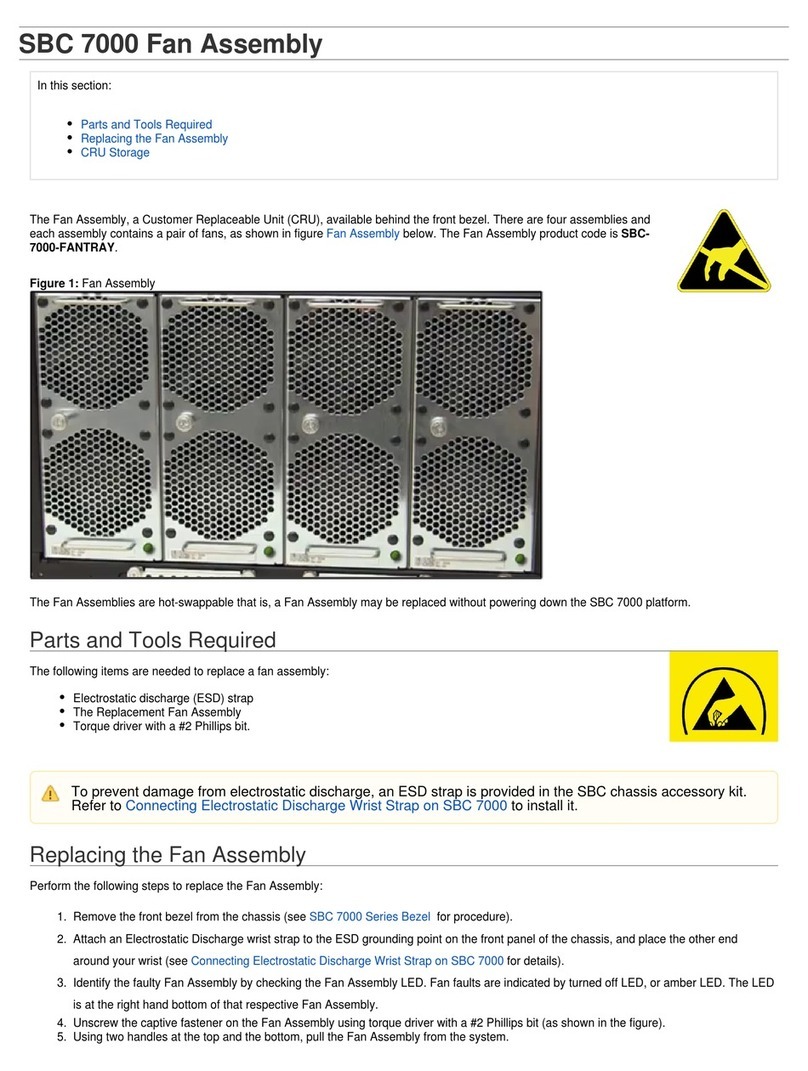
Eci Telecom
Eci Telecom Ribbon SBC 7000 Assembly
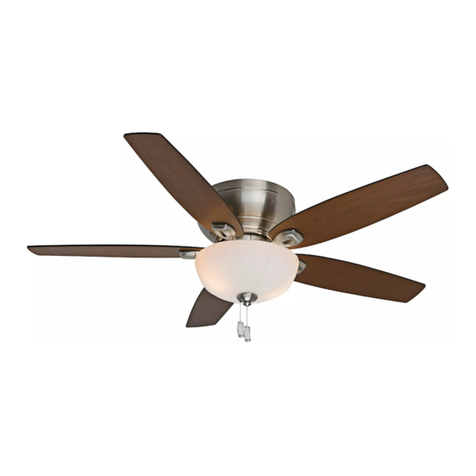
Casablanca
Casablanca Durant 54101 manual
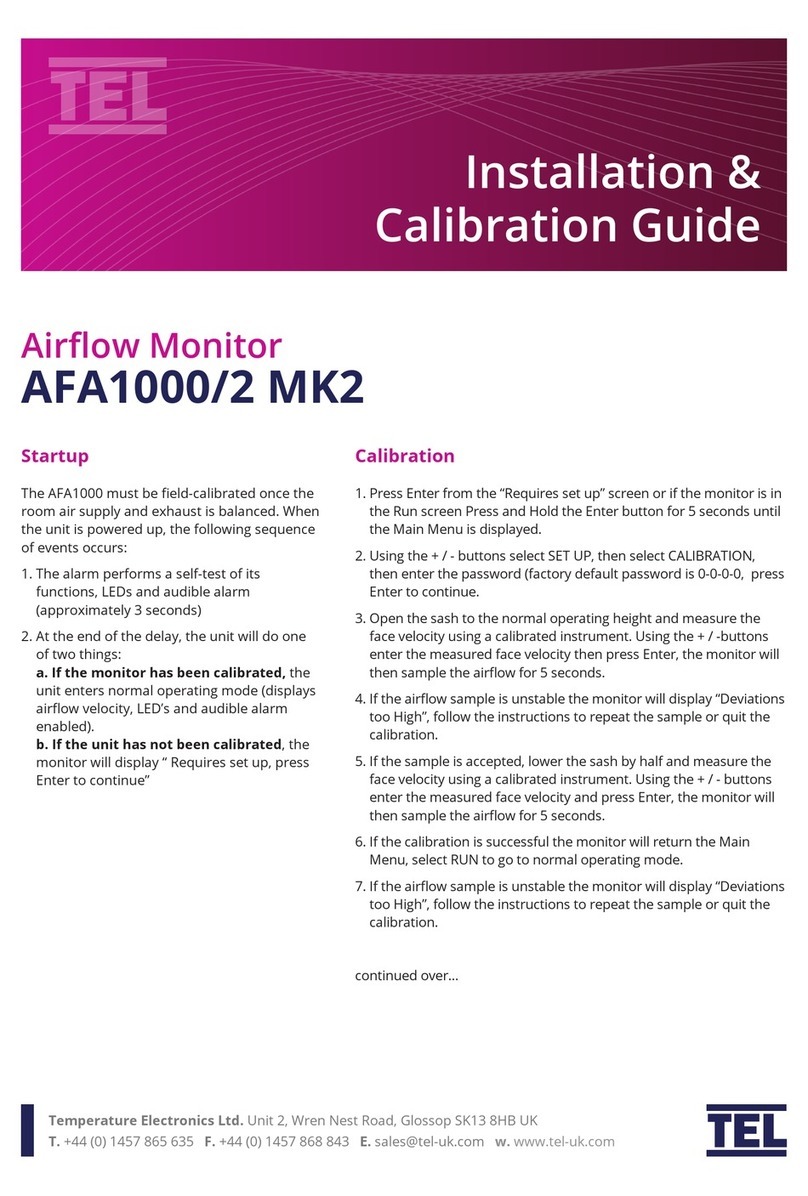
TEL
TEL AFA1000/2 MK2 Installation & Calibration Guide
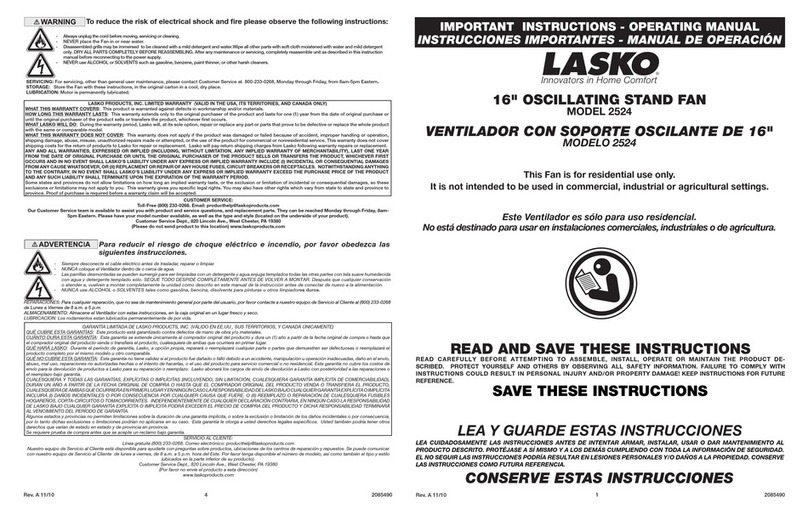
Lasko
Lasko 2524 operating manual

Mitsubishi Electric
Mitsubishi Electric TRANE CITY MULTI Series Service manual

